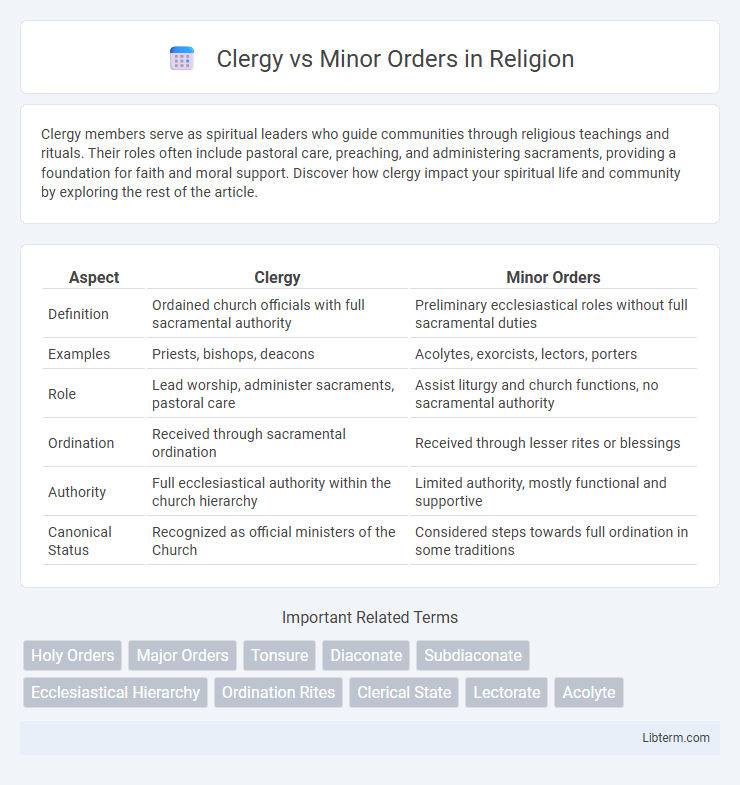Clergy members serve as spiritual leaders who guide communities through religious teachings and rituals. Their roles often include pastoral care, preaching, and administering sacraments, providing a foundation for faith and moral support. Discover how clergy impact your spiritual life and community by exploring the rest of the article.
Table of Comparison
| Aspect | Clergy | Minor Orders |
|---|---|---|
| Definition | Ordained church officials with full sacramental authority | Preliminary ecclesiastical roles without full sacramental duties |
| Examples | Priests, bishops, deacons | Acolytes, exorcists, lectors, porters |
| Role | Lead worship, administer sacraments, pastoral care | Assist liturgy and church functions, no sacramental authority |
| Ordination | Received through sacramental ordination | Received through lesser rites or blessings |
| Authority | Full ecclesiastical authority within the church hierarchy | Limited authority, mostly functional and supportive |
| Canonical Status | Recognized as official ministers of the Church | Considered steps towards full ordination in some traditions |
Introduction to Clergy and Minor Orders
Clergy refers to individuals ordained to perform religious duties and administer sacraments within various faith traditions, primarily in Christianity. Minor orders are preliminary ranks within clerical hierarchy, such as acolytes, lectors, and exorcists, serving as steps before full ordination to major orders like deacon, priest, or bishop. Understanding the distinctions between clergy and minor orders highlights the structured progression and specific roles within ecclesiastical ministry.
Historical Development of Clergy and Minor Orders
The historical development of clergy and minor orders traces back to early Christian communities where ecclesiastical roles evolved from informal leadership to structured hierarchies. Minor orders, including roles such as acolyte, exorcist, lector, and porter, originated as preparatory steps toward full clerical ordination, reflecting the church's need for organized liturgical functions. Over centuries, these distinctions solidified in canon law, influencing the medieval and early modern church's approach to sacramental duties and clerical responsibilities.
Defining Clergy: Roles and Responsibilities
Clergy refers to ordained individuals authorized to perform religious rites, lead congregational worship, and provide spiritual guidance within various faith traditions. Roles of clergy typically include conducting sacraments, delivering sermons, offering pastoral care, and administering church governance. Minor orders, historically distinct from major clergy, involve lower-ranking ecclesiastical roles often responsible for assisting in liturgical functions without full sacramental authority.
Understanding Minor Orders: Functions and Duties
Minor Orders are ecclesiastical roles in the Christian Church that serve as preparatory steps toward full ordination in the clergy, traditionally including porter, lector, exorcist, and acolyte. These roles primarily involve assisting in liturgical functions, such as reading scripture, managing church entrance, aiding in the Eucharist, and performing ceremonial duties. Understanding the functions and duties of Minor Orders highlights their significance in supporting the hierarchical structure and operational aspects of religious services.
Theological Foundations of Both Orders
Clergy and Minor Orders are distinguished by their theological foundations rooted in the Church's sacramental hierarchy, where clergy are ordained to perform sacred mysteries and govern the community, reflecting Apostolic succession. Minor Orders, historically considered preparatory stages, emphasize service and support roles such as acolytes and lectors, reflecting a theological focus on the laity's participation in worship. The sacramental theology underscores clergy's indelible spiritual character, whereas Minor Orders represent functional ministries that facilitate the church's liturgical life without conferring sacramental ordination.
Differences Between Clergy and Minor Orders
Clergy refers to individuals who have received the sacrament of Holy Orders and serve in official religious capacities such as priests, deacons, or bishops, whereas Minor Orders historically were preliminary roles like porter, lector, exorcist, and acolyte that did not confer sacramental status. Minor Orders served as preparatory steps toward full ordination within certain Christian traditions but are no longer considered part of the sacramental hierarchy in the Roman Catholic Church since the reforms of Vatican II. The primary difference lies in the sacramental authority and liturgical functions reserved for clergy, while Minor Orders were primarily service-oriented roles without sacramental ordination.
The Pathway from Minor Orders to Clergy
The pathway from minor orders to clergy involves a structured progression through distinct ecclesiastical ranks, beginning with the reception of minor orders such as acolyte, lector, exorcist, and porter, which serve as preparatory steps for full clerical ordination. Candidates transition from minor orders to major orders, typically including subdeacon, deacon, and ultimately priest, each stage marked by increased liturgical responsibilities and sacramental authority. This hierarchical advancement ensures theological formation and pastoral readiness, culminating in ordination to the clergy with full sacramental and ministerial functions.
Reforms and Changes in Minor Orders
Reforms in Minor Orders have significantly reshaped the traditional clergy hierarchy, streamlining functions previously assigned to minor clerics to enhance efficiency in liturgical and pastoral roles. The Second Vatican Council prompted many Catholic dioceses to either suppress or transform minor orders into lay ministries, reflecting a shift towards greater laity participation. These changes reduced the number of formalized steps to priesthood, emphasizing a more direct path while preserving essential sacramental functions within the clergy.
Contemporary Relevance of Minor Orders
Minor Orders, once essential steps in clerical hierarchy within the Catholic Church, retain contemporary relevance by fostering lay participation and spiritual development. These roles, including lector and acolyte, support liturgical functions without requiring full ordination, enhancing community involvement in worship. Renewed emphasis on Minor Orders aligns with modern ecclesiastical efforts to empower lay ministry amid clergy shortages and evolving parish needs.
Clergy and Minor Orders in Modern Religious Practice
Clergy in modern religious practice typically refers to ordained leaders such as priests, ministers, or pastors who perform essential rites and provide spiritual guidance within their communities. Minor Orders, once distinct steps toward full ordination involving roles like acolytes or lectors, have largely diminished or been redefined in many contemporary denominations, emphasizing practical ministry over hierarchical progression. The evolution of these roles reflects broader shifts in religious institutions towards inclusivity and active lay participation in worship and church functions.
Clergy Infographic

 libterm.com
libterm.com